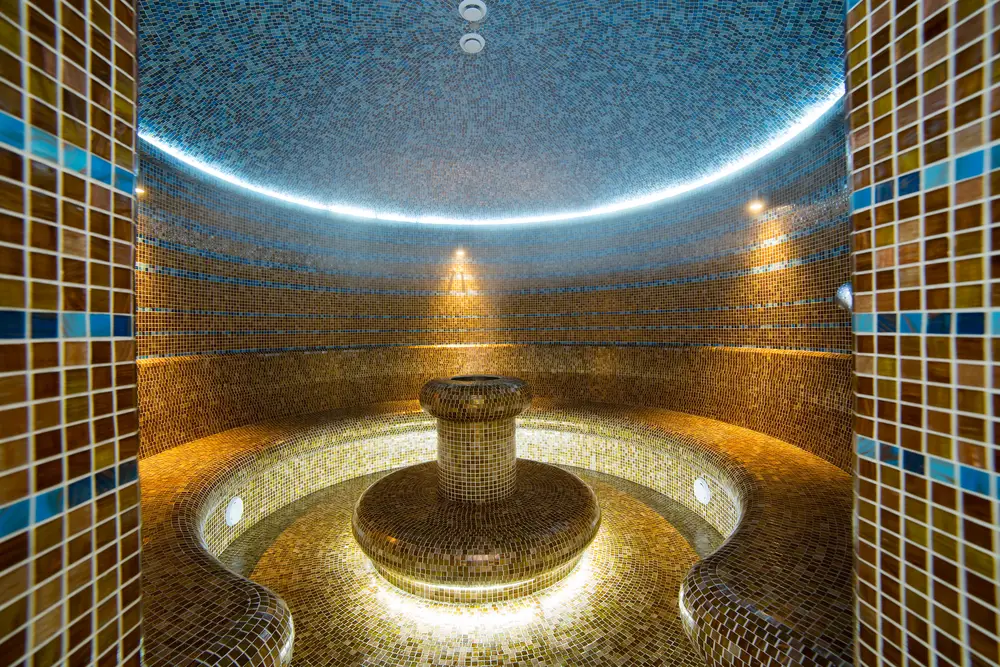Saunas have been a popular form of relaxation and rejuvenation for ages, now you can enjoy a sauna experience at home too. We will delve into the heating options available for your home sauna.
Selecting a home sauna heating system requires evaluating your needs and wants. Options like electric, gas, infrared and wood-burning each have pros and cons to consider. Factor in cost, ease of use, and environmental impact to make the best choice for your sauna experience.
Curious about the many possibilities for sauna heating? Discover the advantages and disadvantages of electric, gas, and wood-burning techniques by reading on.

What are the different sauna heating options?
Options for sauna heating refer to the various methods used to heat a sauna. Electric, gas, wood-burning, and infrared saunas are the most widely available options.
Electric saunas generate heat with electric heating elements that are simple to install and operate. Despite this, they are typically more expensive in terms of energy consumption and may take longer to reach the desired temperature than other sauna heating options.
Wood-fired saunas emit fumes, whereas gas saunas do not. Gas saunas are more environmentally friendly than wood-fired saunas. Gas saunas can be costly to install and may necessitate professional installation.
Wood-burning saunas provide a more authentic sauna experience because they are heated by a wood stove. Nonetheless, this type of sauna is the most difficult to install and maintain, and it emits emissions that some may find problematic.
Infrared saunas employ infrared technology to heat the body directly, as opposed to the air in the sauna. As it only heats the body and not the air, this type of sauna is more energy-efficient, heats up faster, and is less likely to cause overheating.
Also Read: What Temperature are Saunas and Steam Rooms?
How does electric heating work in a sauna?

Due to its rapid heating and low maintenance requirements, electric heating has become the preferred method for saunas. This method involves heating particular stones to a high temperature in an electric stove or heater, which then transfers heat to the air in the sauna via a thermostat.
Electric heating’s short heating time and ability to be utilized indoors without the risk of fire or smoke are two of its primary advantages. In addition, many electric saunas include pre-installed heating elements, making installation simple.
Electric saunas may have a higher initial cost because an electric stove or heater must be purchased, but they are more cost-effective in the long run because they are energy-efficient and do not produce pollutants. However, it is essential to keep in mind that electric saunas may require a dedicated electrical circuit and the initial cost may be more than with other heating alternatives.
If you are considering electric heating for your sauna, it is recommended that you visit a specialist in order to identify the optimal option for your needs. This will enable you to balance the advantages and disadvantages of electric heating and choose the best choice for your specific scenario.
How does wood-fired heating work in a sauna?
Stones heated in a wood-burning stove are the traditional method of heating a sauna chamber by wood-fired heating. Typically composed of cast iron, the stove is constructed to resist extreme heat.
Wood is added to the burner and ignited to heat the stones. The stones generate heat, which is then transported to the sauna’s air. You may manage the temperature of the sauna by altering the air vents or the amount of wood utilized.
The natural aroma and aesthetic appeal of burning wood is one of the benefits of wood-fired heating, which can enhance the sauna experience. A wood-fired sauna is typically less expensive to install than an electric sauna, because wood is a renewable energy source with zero emissions.
However, wood-burning saunas require more upkeep than electric saunas, including cleaning the stove and storing the wood properly to prevent mold and rot. Because of the risk of fire and smoke, wood-burning saunas cannot be used indoors.
Check local regulations and codes for restrictions on wood-burning stoves if you are considering a wood-burning sauna. Before making a decision, it is also essential to examine the availability and cost of wood in the area.
What is the comparison between electric and wood sauna heating?

Electric and wood saunas each have their advantages and disadvantages. Electric saunas are simple to operate and need little maintenance, requiring just to be plugged in.
Typically, they heat up faster than wood saunas, usually within minutes. Due to the heating components being precisely constructed for this purpose and able to maintain a steady temperature, they are also typically more energy efficient.
Wood saunas, in comparison, provide a traditional sauna experience. The warmth produced by the stove, mixed with the natural humidity created by water dropped on hot stones, creates an ambiance that many individuals find more restful.
The milder and more uniformly distributed heat produced by a wood stove is likewise believed to be superior to that of an electric sauna. Initial costs are often lower for wood saunas, but they require continual investments in wood, tools, and maintenance materials.
Electric saunas are typically more expensive to acquire, but have reduced operating costs because they are just plugged in. Because they do not include open flames or hot coals, electric saunas are generally considered safer.
However, it is vital to ensure that the electrical wiring and heating elements are installed and maintained properly, as they can represent a threat if they are broken or not properly grounded.
Saunafin: This is a leading sauna manufacturer and supplier website, providing detailed information about various sauna heating options including electric, gas and wood-burning. They also offer a wide range of sauna heaters, accessories and other related products.
What are the advantages and disadvantages of electric sauna heating?
Electric sauna heating has significant advantages, including simplicity of use and low maintenance requirements. Electric saunas do not require chopping wood or cleaning a stove, as they merely require an electrical outlet. Also, they heat up rapidly, typically within 15 to 30 minutes, making it simple to have a sauna on short notice. Likewise, electric saunas are more energy-efficient because their heating elements are built exclusively for sauna use and maintain a consistent temperature.
Nevertheless, electric saunas have significant drawbacks. In general, they are more expensive than wood-fired saunas. Expert installation and maintenance may be required as the electrical wiring and heating elements must be correctly connected and grounded to prevent safety issues.
Some individuals may believe that electric sauna heating is less real than traditional wood-fired sauna heating. Electric saunas may create less natural-feeling heat, and the whole experience may not be as calming or reminiscent of a traditional sauna.
As there are no open flames or hot coals in electric saunas, they are generally considered safer than wood-fired saunas. To eliminate potential safety issues, it is essential to ensure the correct installation and maintenance of the electrical wiring and heating elements.
What makes infrared saunas different from other types of saunas with their direct body heating method?
Infrared saunas differ from other types of saunas in the way they heat the body. While traditional saunas use hot air to warm the body, infrared saunas use infrared technology to directly heat the body.
The heat generated by infrared saunas is a type of electromagnetic radiation that is not visible to the human eye, but can be felt as heat. This type of heating is different from traditional saunas in that it penetrates deeper into the body, providing a more intense and targeted heat.
One of the key benefits of this type of direct body heating is increased circulation. The heat generated by infrared saunas causes the blood vessels to dilate, which improves blood flow and oxygenation.
This can help to reduce pain and stiffness, as well as improve overall health and well-being. Infrared saunas are also believed to be more effective at detoxifying the body than traditional saunas, as they heat the body more deeply and at a lower temperature, allowing the body to sweat more and release more toxins.
What are the benefits and drawbacks of wood-fired sauna heating?

Consider the specific advantages and disadvantages of wood-fired sauna heating when choosing whether it is the correct option for you. The traditional sauna experience is one of the primary advantages of wood-fired sauna heating.
The warmth generated by the furnace, together with the natural humidity created by the water splashed on the hot stones, provides a unique and calming ambiance that many consider more real than an electric sauna. The milder and more uniformly distributed heat produced by a wood stove is likewise believed to be superior to that of an electric sauna.
Another advantage is cost, as wood saunas are typically less expensive to purchase than electric saunas. Nevertheless, wood saunas require an ongoing investment in wood, tools, and other maintenance supplies, which can accumulate over time.
Wood-fired sauna heating has the potential disadvantage of requiring additional work and maintenance, as you will need to regularly chop wood and clean the stove. As the stove requires time to reach the desired temperature, the heating process may also be slower than in an electric sauna.
Because wood-fired saunas involve open flames and hot coals, safety is also an important factor to consider. It is essential to ensure that the stove is installed and maintained correctly to prevent fire hazards.
What factors should be considered when choosing between electric and wood sauna heating?
When deciding between electric and wood sauna heating, a number of crucial factors must be considered.
The cost is the primary factor. Electric saunas are typically more expensive to purchase initially, but have lower operating expenses because they are simply plugged in. Wood saunas are typically less expensive to acquire initially, but require a recurrent investment in wood, tools, and other maintenance supplies.
Additionally, consider convenience and maintenance. Electric saunas are simple to operate and require little maintenance, whereas wood saunas necessitate chopping wood and cleaning the stove.
Another important factor to consider is safety. Electric saunas are often considered safer than traditional saunas because they do not use open flames or hot coals. However, it is essential that the electrical wiring and heating elements are installed and maintained correctly to prevent potential hazards.
The sauna experience as a whole is another aspect to consider. Some individuals may perceive the heat produced by an electric sauna to be less natural and the experience to be less pleasant than that of a typical wood sauna.
Lastly, it is essential to consider the space and environment in which the sauna will be utilized. Smaller spaces may be more suited for electric saunas, but wood saunas are typically selected for outdoor or rural locations.
The Sauna Place: This is an online store that specializes in sauna products and accessories, including heaters. They provide comprehensive information on different sauna heating options, including the advantages and disadvantages of each, to help customers make informed choices.
